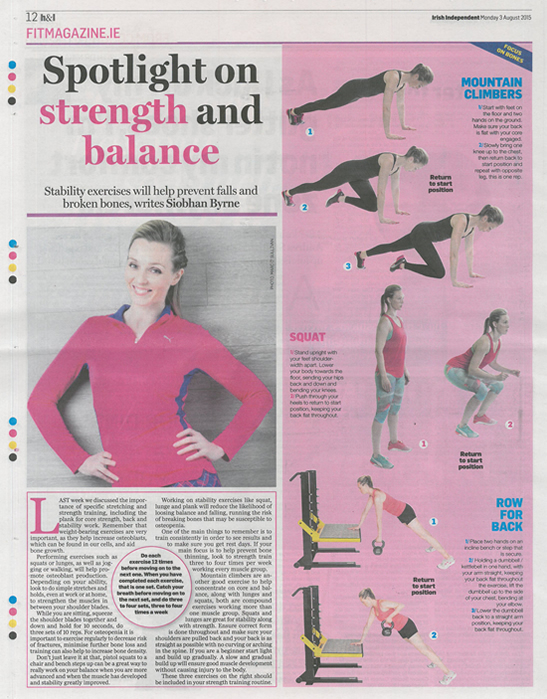Stability exercises will help prevent falls and broken bones.
Last week we discussed the importance of specific stretching and strength training, including the plank for core strength, back and stability work. Remember that weight-bearing exercises are very important, as they help increase osteoblasts, which can be found in our cells, and aid bone growth.
Performing exercises such as squats or lunges, as well as jogging or walking, will help promote osteoblast production. Depending on your ability, look to do simple stretches and holds, even at work or at home, to strengthen the muscles in between your shoulder blades.
While you are sitting, squeeze the shoulder blades together and down and hold for 10 seconds, do three sets of 10 reps. For osteopenia it is important to exercise regularly to decrease risk of fractures, minimise further bone loss and training can also help to increase bone density.
Don’t just leave it at that, pistol squats to a chair and bench steps up can be a great way to really work on your balance when you are more advanced and when the muscle has developed and stability greatly improved.
Working on stability exercises like squat, lunge and plank will reduce the likelihood of loosing balance and falling, running the risk of breaking bones that may be susceptible to osteopenia.
One of the main things to remember is to train consistently in order to see results and to make sure you get rest days. If your main focus is to help prevent bone thinning, look to strength train three to four times per week working every muscle group.
Mountain climbers are another good exercise to help concentrate on core and balance, along with lunges and squats, both are compound exercises working more than one muscle group. Squats and lunges are great for stability along with strength. Ensure correct form is done throughout and make sure your shoulders are pulled back and your back is as straight as possible with no curving or arching in the spine. If you are a beginner start light and build up gradually. A slow and gradual build up will ensure good muscle development without causing injury to the body.
These three exercises (below) should be included in your strength training routine.
Do each exercise 12 times before moving on to the next one. When you have completed each exercise, that is one set. Catch your breath before moving on to the next set, and do three to four sets, three to four times a week.
Focus on bones
Mountain climbers
- Start with feet on the floor and two hands on the ground. Make sure your back is flat with your core engaged.
- Slowly bring one knee up to the chest, then return back to start position and repeat with opposite leg, this is one rep.
Squat
- Stand upright with your feet shoulder-width apart. Lower your body towards the floor, sending your hips back and down and bending your knees.
- Push through your heels to return to start position, keeping your back flat throughout.
Row for back
- Place two hands on an incline bench or step that is secure.
- Holding a dumbbell / kettlebell in one hand, with your arm straight, keeping your back flat throughout the exercise, lift the dumbbell up to the side of your chest, bending at your elbow.
- Lower the dumbbell back to a straight arm position, keeping your back flat throughout.
